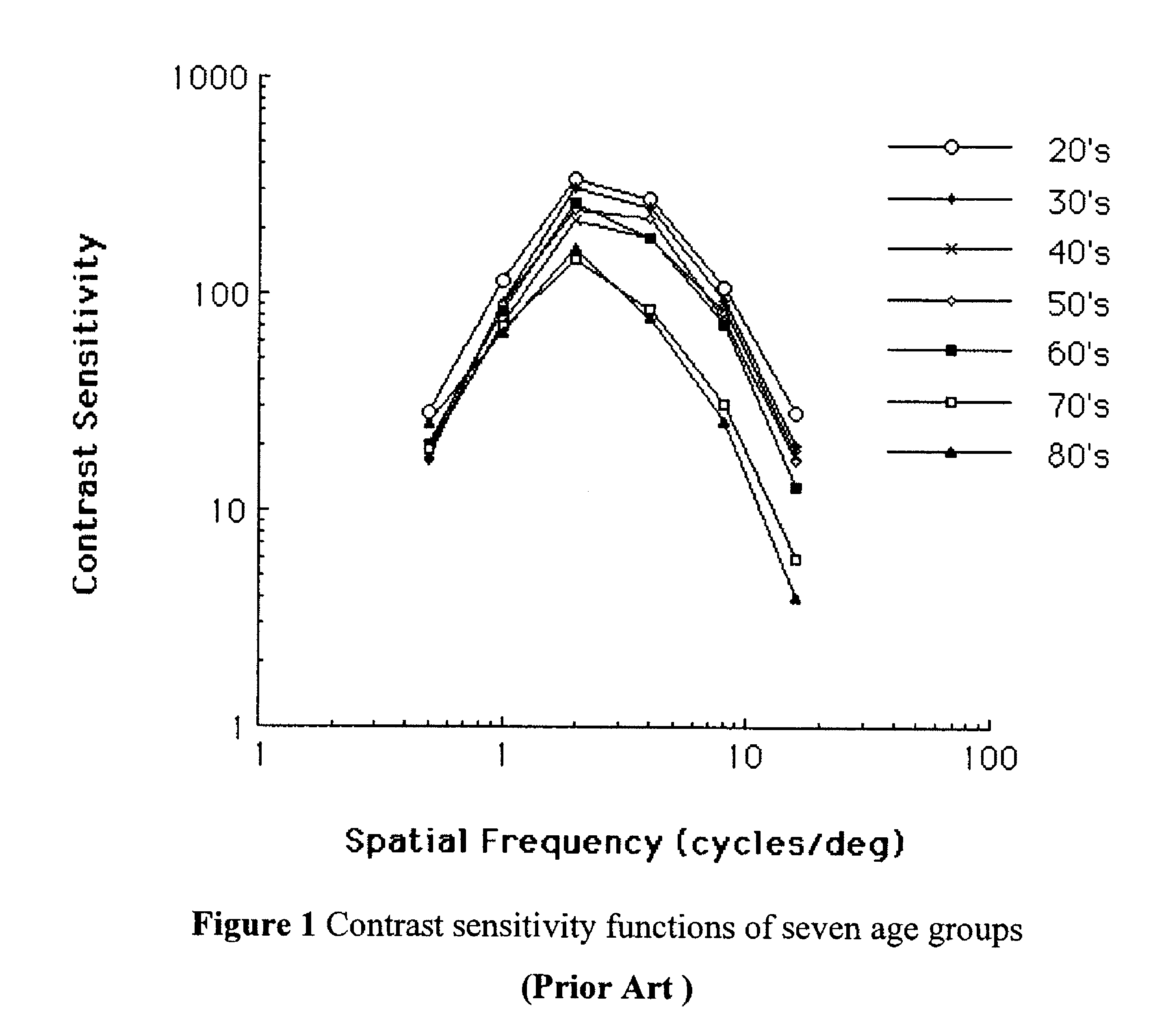Methods and devices for rapid measurement of visual sensitivity
a technology of visual sensitivity and measurement method, applied in the field of visual sensitivity, can solve the problems of insufficient description of spatial visual abilities of individuals by visual acuity measurement, complex and time-consuming procedures, and simple assessment of visual acuity that often does not predict an individual's ability to detect objects of larger siz
- Summary
- Abstract
- Description
- Claims
- Application Information
AI Technical Summary
Benefits of technology
Problems solved by technology
Method used
Image
Examples
example i
Efficient Adaptive Measurement and Classification of Contrast Sensitivity Functions
[0052]Purpose. The contrast sensitivity function (CSF), describing observer's grating sensitivity as a function of spatial frequency1, is a canonical measure of spatial vision. Clinically, a number of visual neuro-pathologies exhibit characteristic CSF deficits2. The cards / charts currently used for clinical testing, though easy to use, limit the sampling range and grain of grating contrast and spatial frequency, and therefore limit test precision. We sought to develop adaptive testing methods that (1) estimate CSFs with the precision of psychophysical testing and short testing time of cards / charts, and (2) classify CSFs into pathological categories based on candidate CSFs with very short test time.
[0053]Method. Describing the CSF with a simple functional form, the quick CSF (qCSF) method searches one-step-ahead for the stimulus contrast and spatial frequency minimizing the expected entropy3-5 of the p...
example ii
Rapid Characterization and Classification of Contrast Sensitivity Functions: the Quick CSF Methods
[0055]The spatial CSF, describing grating sensitivity as a function of spatial frequency, is a psychophysical function fundamental to both basic and clinical vision science. In addition to serving as the front-end filter of spatial vision models and describing neural spatial frequency selectivity of neurons in V1, the CSF can be used to distinguish visual neuropathologies. Clinical CS testing faces several conflicting pressures. The need for short tests and application ease favors the use of cards and charts; in contrast, the need for precision and discriminative power favors psychophysical applications with better stimulus sampling—both the sampling range and grain of grating spatial frequency and grating contrast. We sought to address these needs by developing novel adaptive testing methods that (1) rapidly characterize CSFs with the precision of psychophysical testing, and (2) rapidl...
example iii
Bayesian Adaptive Estimation of the Contrast Sensitivity Function: the Quick CSF (qCSF) Method
[0060]The contrast sensitivity function (CSF), which describes grating sensitivity (1 / threshold) as a function of spatial frequency, is a canonical measure of spatial vision. The CSF is clinically significant, because contrast sensitivity predicts functional vision and several visual neuro-pathologies exhibit characteristic CSF deficits. Current contrast sensitivity cards and charts simplify CSF testing by limiting the sampling range and resolution for grating stimuli. Laboratory procedures for measuring the CSF, though more precise and flexible, are too onerous for clinical use. We sought to develop a CSF procedure providing the best of both worlds: a forced-choice computerized test that estimates the entire CSF across a wide spatial frequency range with a testing time comparable to cards and charts.
[0061]The quick CSF method expands a Bayesian adaptive strategy first applied to estimate m...
PUM
 Login to View More
Login to View More Abstract
Description
Claims
Application Information
 Login to View More
Login to View More - R&D
- Intellectual Property
- Life Sciences
- Materials
- Tech Scout
- Unparalleled Data Quality
- Higher Quality Content
- 60% Fewer Hallucinations
Browse by: Latest US Patents, China's latest patents, Technical Efficacy Thesaurus, Application Domain, Technology Topic, Popular Technical Reports.
© 2025 PatSnap. All rights reserved.Legal|Privacy policy|Modern Slavery Act Transparency Statement|Sitemap|About US| Contact US: help@patsnap.com



